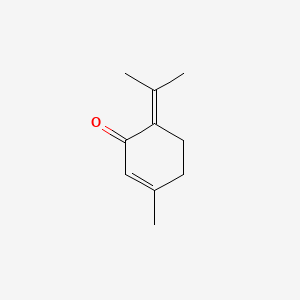| Authors | Title | Published | Journal | PubMed Link |
|---|---|---|---|---|
| Božović M et al. | Mentha suaveolens Ehrh. (Lamiaceae) Essential Oil and Its Main Constituent Piperitenone Oxide: Biological Activities and Chemistry. | 2015 | Molecules | pmid:25985361 |
| Marongiu B et al. | Chemical composition and biological assays of essential oils of Calamintha nepeta (L.) Savi subsp. nepeta (Lamiaceae). | 2010 | Nat. Prod. Res. | pmid:20981614 |
| Rameshkumar KB et al. | Curcuma ecalcarata - new natural source of pinocembrin and piperitenone. | 2015 | Nat. Prod. Res. | pmid:25553726 |
| Negro C et al. | Intraspecific variability of the essential oil of Calamintha nepeta subsp. nepeta from Southern Italy (Apulia). | 2013 | Nat. Prod. Res. | pmid:22646908 |
| Marongiu B et al. | Comparative analysis of the oil and supercritical CO2 extract of Ridolfia segetum (L.) Moris. | 2007 | Nat. Prod. Res. | pmid:17487612 |
| Croteau RB et al. | (-)-Menthol biosynthesis and molecular genetics. | 2005 | Naturwissenschaften | pmid:16292524 |
| Ringer KL et al. | Monoterpene metabolism. Cloning, expression, and characterization of (-)-isopiperitenol/(-)-carveol dehydrogenase of peppermint and spearmint. | 2005 | Plant Physiol. | pmid:15734920 |
| Turner GW et al. | Immunocytochemical localization of short-chain family reductases involved in menthol biosynthesis in peppermint. | 2012 | Planta | pmid:22170164 |
| Lahlou S et al. | Cardiovascular effects of the essential oil of Mentha x villosa and its main constituent, piperitenone oxide, in normotensive anaesthetised rats: role of the autonomic nervous system. | 2001 | Planta Med. | pmid:11582542 |
| Da Rocha MS et al. | Mode of action of pulegone on the urinary bladder of F344 rats. | 2012 | Toxicol. Sci. | pmid:22499580 |
piperitenone
Piperitenone is a lipid of Prenol Lipids (PR) class. Piperitenone is associated with abnormalities such as Dehydration. The involved functions are known as metaplastic cell transformation, cell transformation and Gas retention. Piperitenone often locates in Microsomes, Liver. The associated genes with piperitenone are COX8A gene, P4HTM gene and FATE1 gene.
Cross Reference
Introduction
To understand associated biological information of piperitenone, we collected biological information of abnormalities, associated pathways, cellular/molecular locations, biological functions, related genes/proteins, lipids and common seen animal/experimental models with organized paragraphs from literatures.
What diseases are associated with piperitenone?
piperitenone is suspected in Dehydration and other diseases in descending order of the highest number of associated sentences.
Related references are mostly published in these journals:
| Disease | Cross reference | Weighted score | Related literature |
|---|
No disease MeSH terms mapped to the current reference collection.
PubChem Associated disorders and diseases
What pathways are associated with piperitenone
Lipid pathways are not clear in current pathway databases. We organized associated pathways with piperitenone through full-text articles, including metabolic pathways or pathways of biological mechanisms.
Related references are published most in these journals:
| Pathway name | Related literatures |
|---|
PubChem Biomolecular Interactions and Pathways
Link to PubChem Biomolecular Interactions and PathwaysWhat cellular locations are associated with piperitenone?
Visualization in cellular structure
Associated locations are in red color. Not associated locations are in black.
Related references are published most in these journals:
| Location | Cross reference | Weighted score | Related literatures |
|---|
What functions are associated with piperitenone?
Related references are published most in these journals:
| Function | Cross reference | Weighted score | Related literatures |
|---|
What lipids are associated with piperitenone?
There are no associated biomedical information in the current reference collection.
What genes are associated with piperitenone?
Related references are published most in these journals:
| Gene | Cross reference | Weighted score | Related literatures |
|---|
What common seen animal models are associated with piperitenone?
There are no associated biomedical information in the current reference collection.
